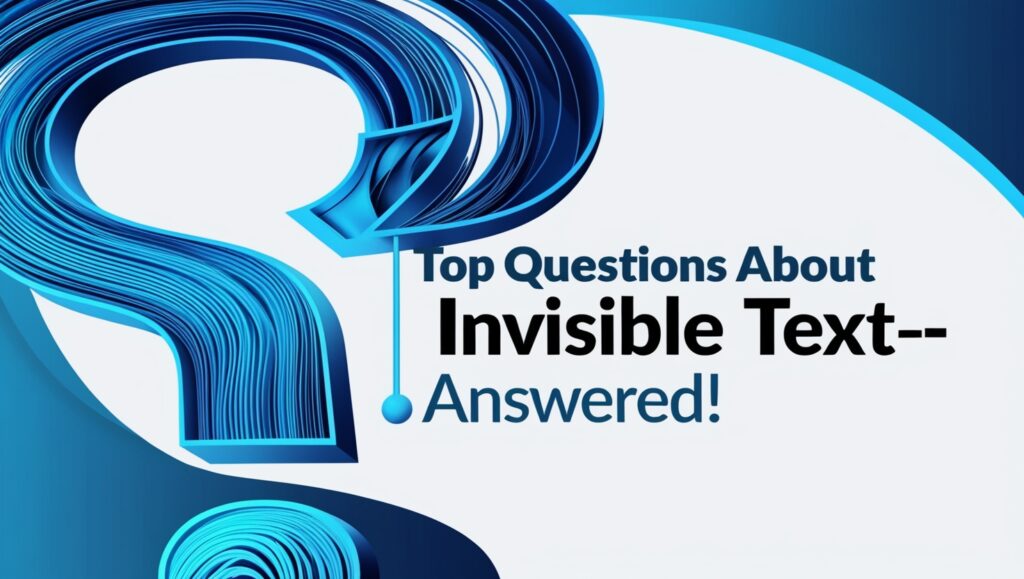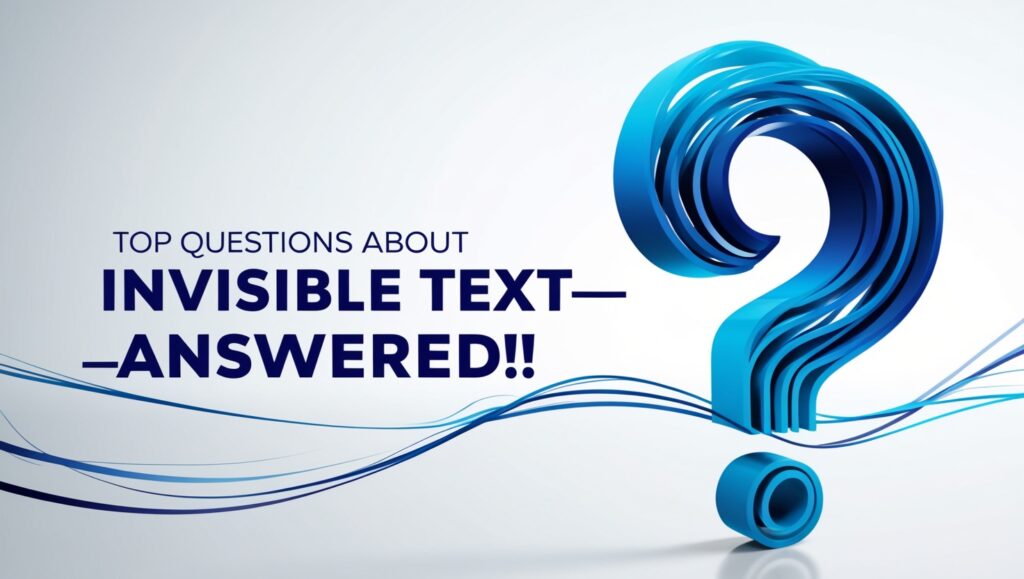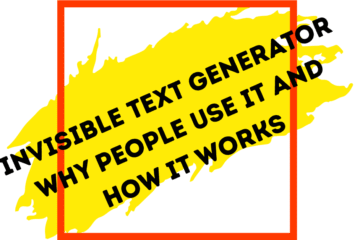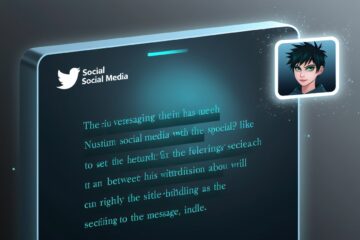As a professional UI/UX manager with years of experience, I’ve encountered numerous questions about invisible text. This article aims to address the most common inquiries, providing clear, concise answers suitable for both beginners and seasoned designers.
What Is Invisible Text?
Invisible text refers to characters or elements in digital content that are present in the code but not visible to the user. This can be achieved through various methods, including:
- Zero-width characters: Unicode characters like U+200B (zero-width space) that don’t render visibly.
- CSS properties: Using visibility: hidden, opacity: 0, or display: none to hide elements.
- HTML attributes: Employing aria-hidden=”true” to hide elements from assistive technologies.
These techniques are often used for formatting, accessibility, or adding hidden metadata.
Is Invisible Text Bad for SEO?
Using invisible text solely to manipulate search engine rankings is considered a black-hat SEO tactic and can lead to penalties. However, when used appropriately—for instance, to enhance accessibility—it is acceptable. Google’s guidelines on hidden text and links provide detailed information on acceptable practices.
How Does Invisible Text Affect Accessibility?

Invisible text can significantly improve accessibility when used correctly. For example, screen readers can interpret hidden labels or instructions, aiding users with visual impairments. Techniques include:
- Visually hidden elements: Using CSS to hide elements visually while keeping them accessible to screen readers.
- ARIA attributes: Implementing aria-label or aria-describedby to provide additional context.
For comprehensive guidelines, refer to the WAI-ARIA Authoring Practices.
Can Invisible Text Be Used in Social Media?
Yes, invisible text can be utilized on platforms like WhatsApp, Instagram, and Discord to create blank messages or add spacing. This is often achieved using zero-width characters. However, excessive use may violate platform guidelines or confuse recipients.
Is It Legal to Use Invisible Text?
The legality of using invisible text depends on its purpose. Using it for accessibility or formatting is legal and encouraged. However, employing it to deceive users or manipulate search rankings can lead to legal issues or platform bans.
How Can I Generate Invisible Text?
Several online tools allow you to generate invisible text using zero-width characters. These tools can be useful for formatting or creating hidden messages. Always ensure that your use complies with relevant guidelines and policies.
What Are the Risks of Using Invisible Text?
While invisible text has legitimate uses, risks include:
- SEO penalties: If used to manipulate rankings.
- User confusion: If it affects readability or navigation.
- Accessibility issues: If not implemented correctly.Brbnry | Bourbon and Rye Whiskey Reviews
It’s essential to use invisible text responsibly and test its impact on user experience.apnews.com+14Fat Baby Bourbon+14LEAFtv+14
How Does Invisible Text Work in HTML and CSS?
In HTML and CSS, invisible text can be created using various methods:
- CSS: Applying visibility: hidden hides the element but retains its space; display: none removes it entirely.
- HTML: Using aria-hidden=”true” hides elements from assistive technologies.
Understanding these properties is crucial for effective implementation.
Can Invisible Text Be Detected?
Yes, invisible text can be detected through:
- Browser developer tools: Inspecting elements reveals hidden content.
- SEO tools: Analyzing a website’s code can uncover hidden text.
- Screen readers: May read out hidden content, depending on implementation.
Regular audits can help ensure that invisible text serves its intended purpose without unintended consequences.
Is Invisible Text Used in Design Tools?
Design tools like Figma and Adobe XD allow for the creation of invisible elements, aiding in layout and alignment. These tools support the use of hidden layers and guides, which can be essential for precise design work.
Summary Table
| Question | Key Takeaway |
| What is invisible text? | Hidden characters or elements in digital content. |
| Is it bad for SEO? | Only if used to deceive; acceptable for accessibility. |
| How does it affect accessibility? | Enhances it when used correctly. |
| Can it be used in social media? | Yes, but use responsibly. |
| Is it legal? | Legal when not used deceptively. |
| How to generate it? | Use online tools for zero-width characters. |
| Risks involved? | SEO penalties, user confusion, accessibility issues. |
| Implementation in HTML/CSS? | Use CSS properties and ARIA attributes appropriately. |
| Detection methods? | Browser tools, SEO analyzers, screen readers. |
| Use in design tools? | Supported for layout and alignment purposes. |
For further reading on best practices and guidelines, consider visiting W3C Web Accessibility Initiative and Google’s SEO Starter Guide.
Certainly! Here’s the continuation and conclusion of the article “Top Questions About Invisible Text—Answered!” with more advanced use cases, a few industry insights, and final thoughts for both beginners and professionals.
Can Invisible Text Be Used in Gaming or Interactive Design?
Yes, invisible text has found unique applications in gaming interfaces and interactive design. Designers and developers often use it to:
- Create secret cheat codes or Easter eggs that respond to invisible triggers
- Enable touch-based hotspots in mobile gaming UIs
- Control dynamic text alignment without disrupting visible content
- Hide developer debug notes during early release testing
In platforms like Unity, Unreal Engine, or even browser-based games, invisible elements play a behind-the-scenes role. Game designers also sometimes embed invisible Unicode characters to influence how player names display or align on leaderboards—especially in multiplayer environments.
Want to see fun examples of this in action? Check out how developers create invisible triggers in Godot Engine’s official docs.
Can Invisible Text Help with Multilingual Websites?

Yes. Multilingual websites often use invisible text or non-breaking space characters to control layout without interfering with translation engines. Smart uses include:
- Wrapping hidden Unicode markers around phrases to prevent improper translation
- Adjusting spacing between mixed-language headers
- Controlling RTL (right-to-left) or LTR (left-to-right) rendering in dynamic scripts
For instance, when managing a project in both Arabic and English, I had to use ‎ (left-to-right marker) to maintain proper formatting across breakpoints. It was a life-saver for clean design without confusing the language logic of the browser.
To understand more about language control using invisible characters, visit Unicode.org’s bidirectional algorithm guide.
How Do Professionals Use Invisible Text During Development?
Invisible text is an everyday tool during development and staging environments. As a UX manager, I’ve used it to:
- Leave internal notes directly inside HTML templates that don’t render for users
- Add temporary labels or placeholders that disappear on launch
- Hide A/B testing variants until one is selected for public rollout
- Preserve structure during responsive layout shifts
For development teams, the trick is to ensure all invisible debugging content is cleaned out before publishing live. Using tools like Lighthouse or automated audits via GitHub Actions helps enforce this.
Are There Browser or Platform Limitations?
Generally, invisible text behaves consistently across modern browsers like Chrome, Firefox, Safari, and Edge. However, some older browsers or low-end mobile devices may render hidden characters incorrectly or not support all Unicode types.
Mobile apps using React Native, Flutter, or SwiftUI may require extra handling when using invisible Unicode characters. Especially when sending data through messaging apps or over SMS APIs, hidden characters can break rendering or even crash apps if encoding isn’t managed properly.
Check MDN Web Docs for up-to-date compatibility info on specific CSS and Unicode techniques.
What’s the Difference Between Invisible Text and Transparent Text?
This is a very common question. Here’s the core difference:
- Invisible Text: Can’t be seen or interacted with visually (like using display: none or inserting zero-width spaces)
- Transparent Text: Still occupies space but is fully see-through, usually via color: transparent or opacity: 0
The distinction matters when you’re building interactive elements. For example, transparent text may still trigger click events or keyboard navigation, while fully hidden text usually does not.
Is There a Way to Detect Misuse of Invisible Text?
Yes. If you’re a website auditor, marketer, or SEO specialist, you can detect misuse using:
- Google Search Console – flags unnatural hidden content
- SEO tools like Ahrefs or SEMrush – highlight hidden keyword stuffing
- Browser dev tools (Inspect Element) – view all DOM content
- Screen readers – test content spoken aloud to users
Invisible content used for manipulation will almost always show up under scrutiny, and search engines continue to improve their detection mechanisms.
Here’s a tool to test and analyze your own content: WAVE Web Accessibility Tool
Final Table: Key Use Cases of Invisible Text in 2025
| Use Case | Tool/Method | Safe or Risky? | Notes |
| Accessibility (Screen Readers) | aria-label, hidden spans | ✅ Safe | Improves usability |
| SEO Keyword Stuffing | Hidden keywords | ❌ Risky | May result in penalties |
| Spacing Adjustments | Zero-width spaces | ✅ Safe | Useful for clean layout |
| Debugging Notes | display: none | ✅ Safe (dev only) | Remove before live deployment |
| Gaming Easter Eggs | Hidden interactive areas | ⚠️ Medium | Fun, but needs transparency |
| Social Media Gimmicks | Blank or glitch messages | ⚠️ Medium | Avoid abuse |
| Multilingual Formatting | Unicode direction markers | ✅ Safe | Controls display logic |
| Tracking Behavior (Hidden) | Unmarked click zones | ❌ Risky | Violates transparency norms |
| A/B Testing Content | Invisible variants | ✅ Safe (if cleaned) | OK in dev environments |
| Transparent Text for Tricks | color: transparent | ⚠️ Medium | May confuse users or cause UX bugs |
Final Thoughts from a UX Manager
Invisible text, when used responsibly, is one of the smartest hidden tools a designer or developer can use. Over my years in the industry, I’ve seen teams use it to craft elegant layouts, improve accessibility, and enhance app performance. I’ve also seen it backfire when used to manipulate or deceive.
Always remember: transparency, user intent, and best practices should guide how and why you use invisible content.
Invisible text isn’t just about hiding—it’s about enhancing the experience where visual clutter would otherwise get in the way. If you keep the user at the center of your decisions, you’ll know exactly when to use it—and when to leave it out.



